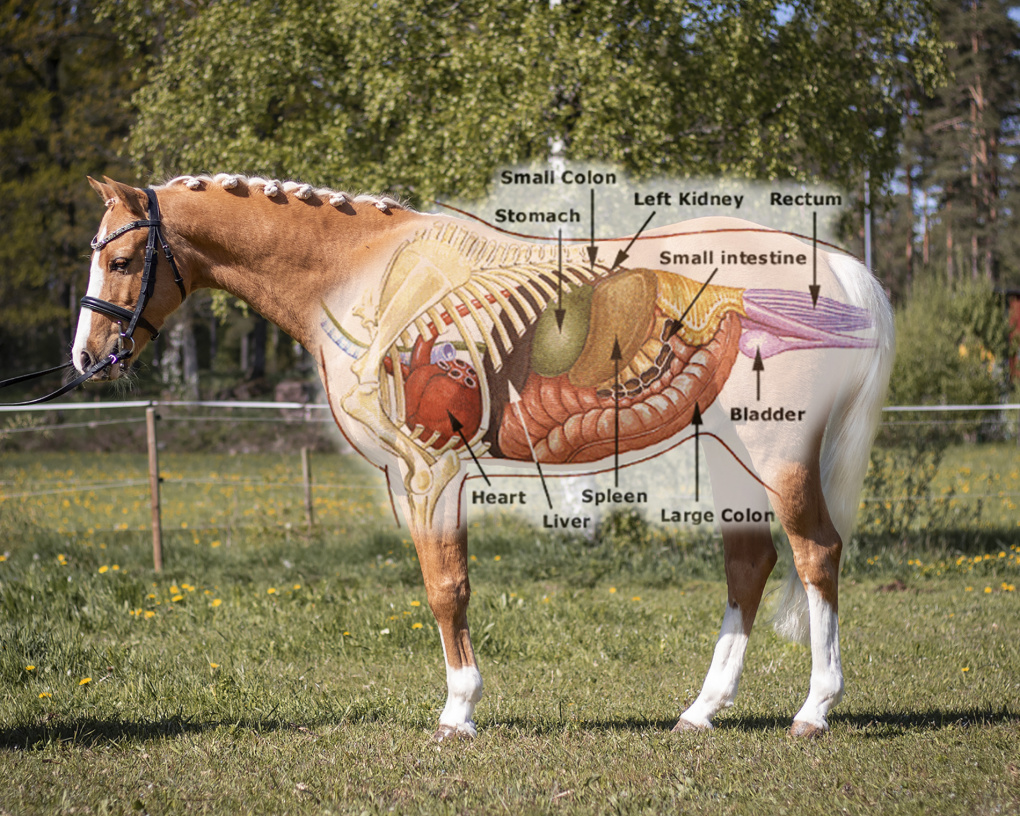
Tips for horse gut health
More and more horses are getting stomach ulcers due to incorrect feeding, stress, and hard training and it must be taken seriously by us as horse owners. Here we want to give tips on how to detect stomach ulcers and how you can help prevent them. Stomach ulcers are fundamentally caused by an imbalance in the protective mucous barrier in the stomach which leads to the acid splashing up from the lower red part of the stomach to the upper white sensitive part of the stomach. Several studies show that the majority of horses have stomach ulcers:
| Percentage w/ lesions | Quantity of horses w/ lesions | Total number of horses | Study |
| 86 % | 297 | 345 | Begg & O’Sullivan, 2003 |
| 73,2 % | 52 | 71 | Bezdekova et al., 2007 |
| 70,6 % | 132 | 187 | Murray & Grodinsky, 1989 |
| 70 % | 56 | 80 | Egenvall & Jonsson, 2006 |
| 44 % | 121 | 275 | Dionne et al., 2003 |
*Statistics from SLU 'Causes of gastric ulceration in horses' - Moa Berggren
Why so many stomach ulcer issues in horses?
Feeding large meals a few times a day predisposes horses to stomach ulcers, as do feed regimens containing large amounts of concentrated hard feed and grains. Studies also show that stress, such as during movement and anxiety in the stable or during transportation, increases the risk of developing stomach ulcers. Even hard physical activity increases the risk of stomach ulcers as studies show that exercise increases the production of stomach acid and reduces blood flow to the intestinal mucosa. Hard training also causes the intestines and other abdominal organs to press on the stomach, which in turn makes stomach acid more likely to splash up onto the white sensitive part of the stomach. Sores are most commonly seen in the upper white part of the stomach but can also be seen in the lower red part. Sores in the lower red part of the stomach are also often seen after prolonged treatment with anti-inflammatory drugs.
Signs of stomach ulcers
Most horses with stomach ulcers show no outward symptoms but sometimes one or more of the following symptoms may be observed:
- Cribbing
- Sensitivity to rider's leg aids or when tightening the girth
- Biting at the abdomen
- Poor appetite
- Loose stool
- Depression
- Decreased performance
- Mood swings
- Negative attitude towards training
- Difficulty maintaining weight
- Poor coat condition
- Weight loss
- Lying down more than usual
- Mild colic
How do you diagnose stomach ulcers correctly?
The safest way to find out if a horse has stomach ulcers is to perform an endoscopic examination of the stomach. Endoscopic examination involves inserting a long tube, equipped with a light and video camera, down through one of the horse's nostrils to look at the stomach and its protective lining. Stomach ulcers can occur in various places in the stomach and the severity can also vary from small spots to large open sores. An accurate investigation conducted by an experienced veterinarian in combination with good endoscopic equipment is therefore of great importance in choosing treatment and continued long-term care.
Tips that you as a horse owner can do to avoid your horse getting stomach ulcers:
• Feed small meals of roughage several times a day or provide free access to hay/grass if the horse can handle it.
• Reduce the amount of concentrated hard feed and grains in the diet.
• Avoid stressful situations if possible and ensure that your horse gets good quality rest in the stable and pasture.
• Avoid or reduce the amount of anti-inflammatory medication. Consult your veterinarian.
• Pre-training feeding - give the horse a small portion of hay before training. It acts as a lid and prevents acidic splashes of stomach acid during the training session.
• Fiber before starch! Avoid grain rations as they are harder to break down in the stomach than fibers such as hay. Avoid overfeeding with protein and sugar.
If your horse still develops stomach ulcers, that will require treatment in consultation with a veterinarian. It is important to also review feeding routines, diet, stable environment, training schedule, etc. to help the sores heal.
The horse - an animal made to eat most of the day
Horses are grazing animals by nature, and can graze for up to 22 hours a day in the wild. Horses constantly produce hydrochloric acid (even when not eating); when the horse ingests food, saliva secretion is triggered by chewing motion. It neutralizes the stomach contents and protects the stomach wall from corrosive gastric juice. Saliva is a natural buffer against stomach acid; during exercise, the normal process of food intake is interrupted. This can lead to inadequate amounts of saliva, as it is only produced when the horse eats. Eating breaks over four hours should be avoided due to the risk of acidification; the resulting stomach acid attacks unprotected parts of the stomach / the protective mucous lining and irritates sensitive stomach tissue.

 SWE
SWE ENG
ENG NO
NO AX
AX DE
DE